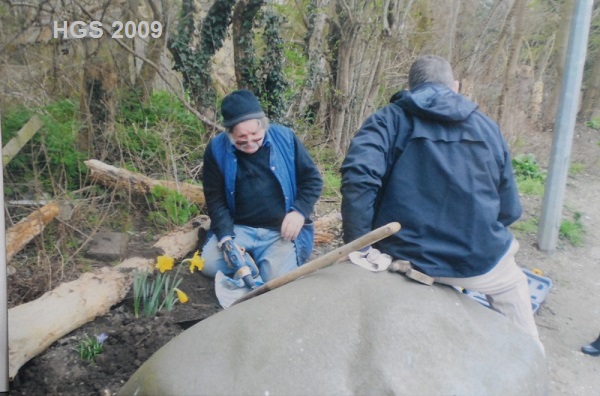

Humberside Geologist no 16
The Hornsea Tesco Boulder.
By Dennis Haughey, Mike Horne and Stuart Jones.
In 2009, the Hull Geological Society was contacted
about a boulder in Hornsea beside the road junction on Southgate and Hull Road
(NGR TA20244704). It was thought by locals that the future of the stone was
threatened by the development of the nearby site by Tesco. This rock was known
to locals as a boundary marker and, according to local legend, had stood in the
middle of the junction until it was moved to the side of the road when it was
metalled about 100 years ago.
It is a rounded brown erratic about 1.35m x 1.15m and
standing about 0.6m high above ground level. There are definite scratches at the
back of it - perhaps from transportation in a glacier. When we first visited, it
was not in very salubrious surroundings - there was a lot of broken glass around
it and it had a distinctive aroma! In 1896 W H Crofts recorded “at
south end of the old village, at junction of the Hull Road with the main street,
a boulder of dolerite 57” by 42” by 18".” This seems to be the same boulder.

Photo by S Jones
When asked to identify the rock we explained that
geologists would need to see a fresh un-weathered sample, but it would be a
shame to damage it by hammering. Felicity (Fliss) Clayton (Renaissance
Coordinator at East Riding of Yorkshire Council)
agreed to
members of the HGS removing a core from the boulder. Stuart Jones and Dennis
Haughey met Fliss at the site, which had now been cleaned up and planted with
flowers. They dug down a little and then drilled out a 2" core from the
underside of the boulder. Then they knocked off the outer weathered surface of
the core and cemented it back in place, using the powder from the drilling to
mix the cement.

Dennis took half of the core and made a thin section
and a polished disc from the sample. We then looked at these at one of the HGS
Friday Microscopy evenings. Here are our conclusions:
Hand specimen - overall grey colour. On a broken
surface we could see white minerals and pink patches, as well as some well
defined, black crystals with a vitreous lustre.
The pink patches are not a pink mineral, but a pink staining.
The rock
weathers brown: onion skin weathering.
Polished section - overall dark grey colour. Grain size
generally 0.5 mm but with some long thin crystals up to 2 mm long. It contains
cubic crystals of pyrite, these make up about 1% or 2% of the rock.
Thin section - the dominant mineral is rotting
elongated feldspar, some crystals of which exhibit multiple twinning, but due to
the weathering to clay most have the appearance of simple twinning. Opaque
minerals make up 10% to 15% of the rock, some of these are square in cross
section (probably pyrite). There are some zoned minerals with second order
birefringence. A greenish mineral with a "crazy paving" appearance is also
present (probably olivine), as are small amounts of strained quartz and biotite
(brown pleochroic with good cleavage).
We later compared it with specimens in the University
Collection and some samples of the Whin Sill collected by Dennis. Our conclusion
was that we could not prove the erratic was not from the Whin Sill.
Tesco agreed to reposition the boulder and a local
historian wrote the (geologically inaccurate) information displayed on a
stainless steel structure which was unveiled on 24th February 2012
(HARP 2012).

Picture of Stuart at the site in 2019
References –
Anon 1896 – Report of the East Riding Boulder Committee
1896. Transactions of the Hull Geological
Society, 3, 6-9
HARP 2011 - Glacial erratic p 6-7 of Hornsea Area
Renaissance Partnership 2011/12 report and 2012-13 Action Plan, 12pp
HARP 2012 (press release) – Hornsea unveils its Glacier
Erratic
If you enjoyed reading the article please consider joining the Society or sending a donation.